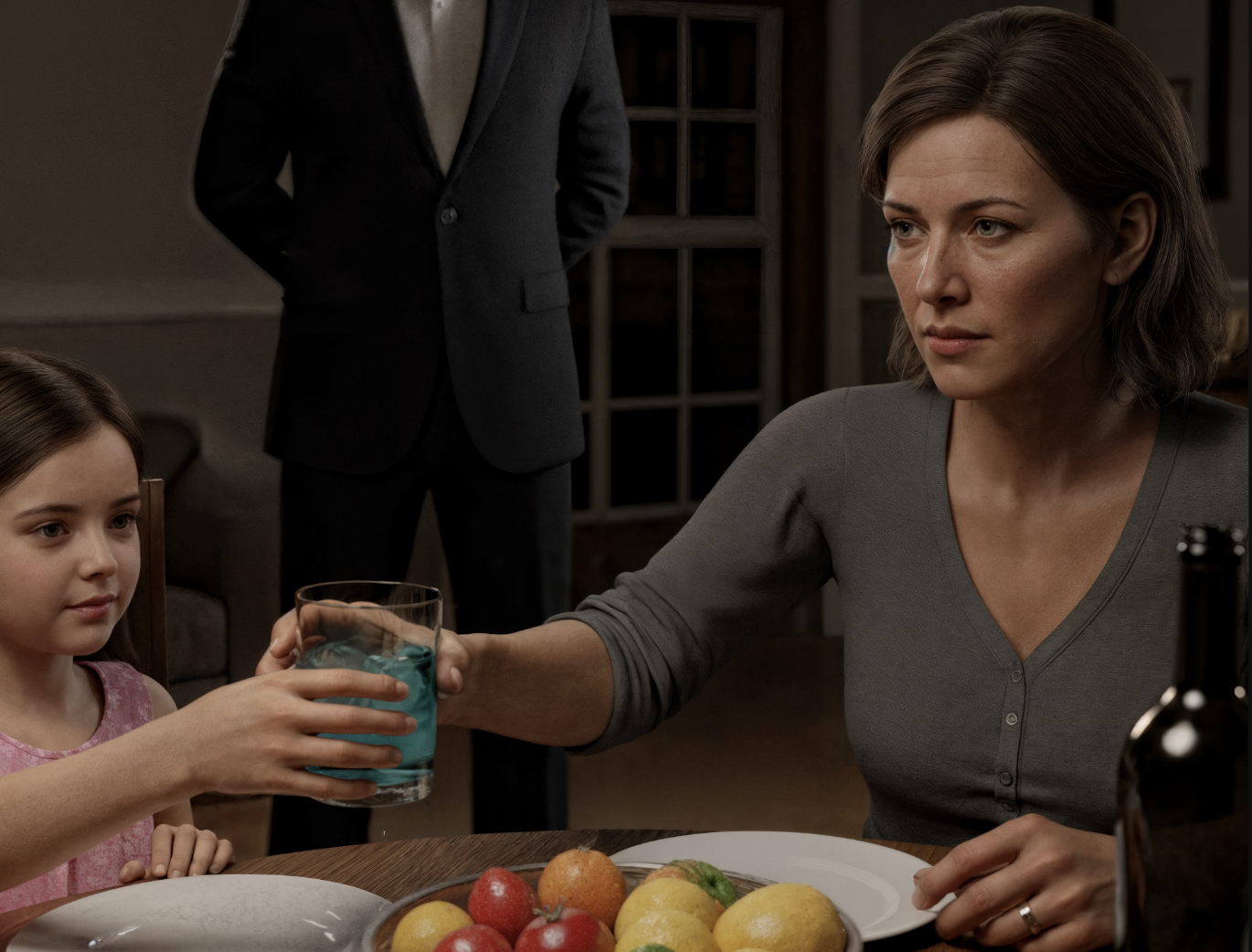Mary and James had been together for nearly a year when they finally decided to tie the knot. Many thought their decision was rushed. Yet, as a woman approaching forty and having raised her daughter alone for a decade, Mary believed she deserved a chance at happiness.
James appeared to be the perfect partner: intelligent, generous, always arriving with fresh flowers, preparing dinners, and even assisting Ellie, Mary’s nine-year-old daughter, with her math homework. Mary felt grateful to see him fit effortlessly into their routine. However, Ellie remained distant and reserved.
From the beginning, the young girl was wary of James. Even post-marriage, Ellie hadn’t shown any signs of warming up to him. Mary attributed this behavior to the natural adjustment period—children often take time to accept a new parental figure.
One particular Saturday evening, James arranged a small celebration at their home, just the three of them. He cooked steak with mashed potatoes and opened a bottle of red wine. Candles flickered softly on the table while smooth jazz played gently in the background. Mary donned her favorite green dress, feeling more at ease than she had in weeks.
As they sat together, Mary noticed Ellie’s apprehensive gaze directed at the wine glass placed in front of her mother, her complexion pale as though alarm had settled over her.
James poured the wine and raised his glass with a warm smile, saying, “Here’s to us!”
As Mary lifted her glass to drink, Ellie’s sharp voice suddenly pierced the quiet.
“Mom, don’t drink from that glass! The new dad put something in it!”
The moment seemed frozen in time. Mary’s hand halted inches from her mouth. James looked toward Ellie with an unreadable expression.
“What are you talking about?” he asked calmly, though his eyes hardened.
Ellie, tears in her eyes, responded, “I saw you take something out of your pocket before dinner, coming from the kitchen. I heard you mix it into the wine. I hesitated, but I saw what you did.”
Mary turned her gaze to James. He laughed nervously.
“Sweetheart, you’re just a child. You must be mistaken. I only added sugar to my glass — you know I like my wine a bit sweet.”
Yet Mary sensed something was wrong. She took both glasses and smelled their contents: nothing unusual. Then she said firmly, “Let’s swap the glasses.”
James hesitated.
“Come on, Mary…”
“Please, trust me.”
Reluctantly, he handed over the glasses. Mary took them to the kitchen and poured samples into two cups, storing them in the refrigerator. She planned to have them tested Monday at the clinic’s lab where she worked. Although basic, the toxicology tools there would detect most substances.
She returned calmly to the dining room and said, “I’m not feeling well. Could we skip the wine tonight?”
James nodded uneasily. “Alright.”
Ellie clung to her mother’s arm, trembling.
That night, Mary stayed awake listening to Ellie’s peaceful breathing. What exactly had James placed in her glass? Early Monday, Mary went to the clinic, locking the samples in a secure case. After her shift ended at 5 p.m., she proceeded with the analysis.
The findings terrified her: the sample meant for Mary contained zolpidem, a powerful sedative prescribed for insomnia. At low doses, it induces drowsiness; in higher amounts, it can cause confusion, amnesia, or loss of consciousness.
This was no accident. Someone had acted intentionally. Trembling, Mary printed the report, slipped it into her bag, and left the clinic, virtually unaware of her colleagues’ supportive words.
Back home, with James asleep, she searched through his papers. In a drawer titled “Tax Documents,” she uncovered photocopies of old IDs bearing different names and birthdates. She also found a small notebook filled with women’s names, sums of money, and durations. Additionally, several photographs caught her eye: some were casual selfies of James with unknown women; others were stealthy snapshots, taken without the subjects’ knowledge.
On the notebook’s last page, a photo showed Mary and Ellie by their front door, annotated in red:
“Mary R. – access to medications via clinic. Plan imminent, no witnesses.”
Below that was a chilling note:
“Child too observant. Delay plan.”
Mary’s blood ran cold. She replaced everything, woke Ellie before dawn, and whispered, “Pack your bag; we’re going to grandma’s for a few days.”
They left while James was outside in his jogging clothes, leaving a note claiming Mary was unwell.
That afternoon, armed with the lab report, samples, and discreetly taken photos, Mary visited the police station. Two days later, officers raided their home and found in James’s car multiple sedatives, disposable phones, wigs, and a fake passport. James’s real identity was Jonathan Myers, wanted for fraud, identity theft, and suspected involvement in disappearances.
His arrest took place at a storage facility thirty kilometers away. Showing no resistance, he remained silent.
Over the following months, Mary and Ellie rebuilt their lives through therapy and steadfast support from loved ones. Ellie became their unsung hero: her grave warning during dinner had averted a disaster.
Key Insight: From that day forward, Mary never drank wine again—not out of fear but as a tribute to their vigilance and Ellie’s bravery.
Every night before sleeping, Mary would softly say, “Thank you for watching over me, Ellie. You saved my life.”
This story reminds us of the critical importance of trust, intuition, and vigilance within families. It highlights how a child’s courage and observation can change the course of events, safeguarding those we love most. Mary and Ellie’s experience underscores the necessity of paying attention to subtle warning signs, no matter how difficult they may seem.
